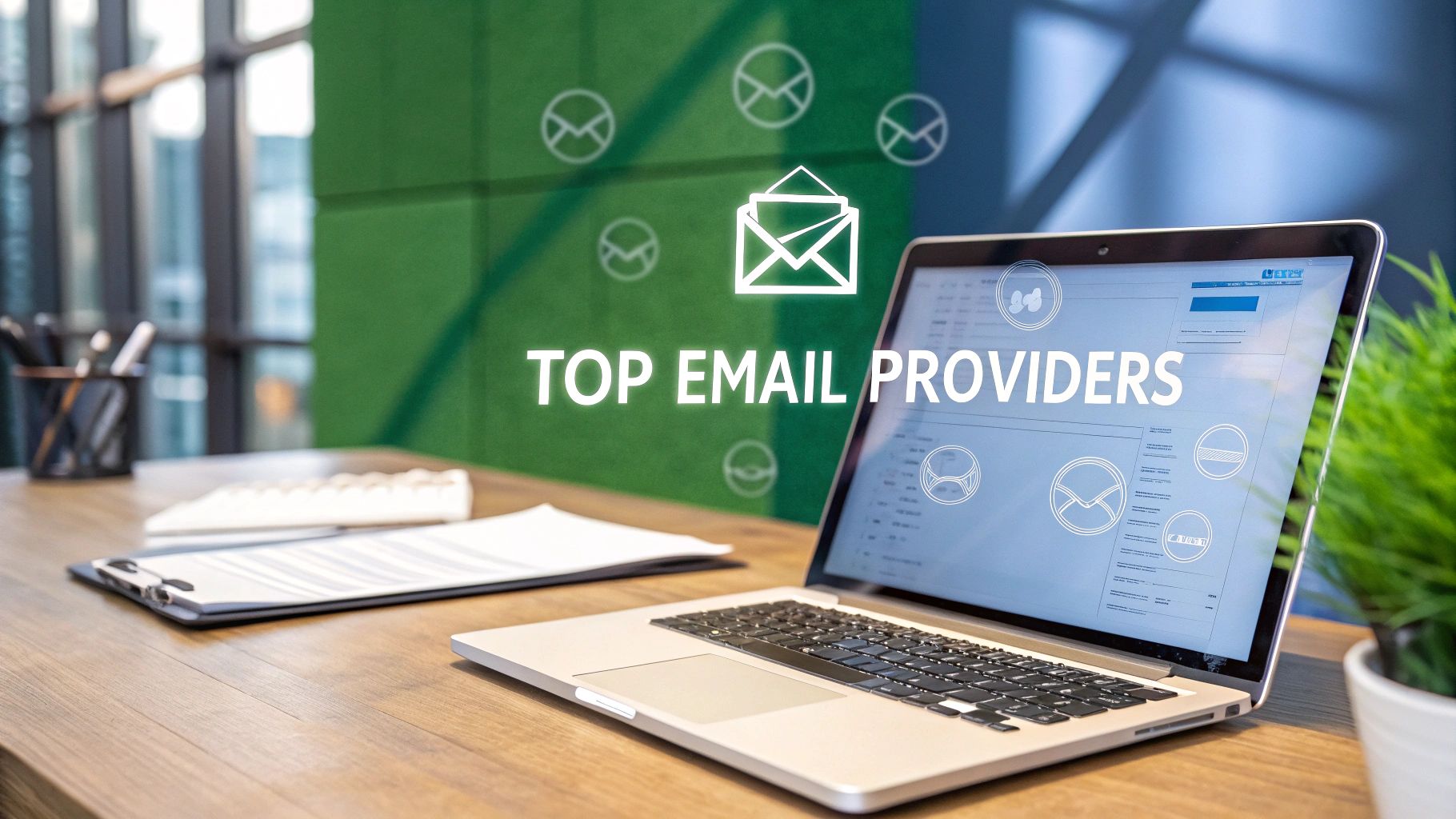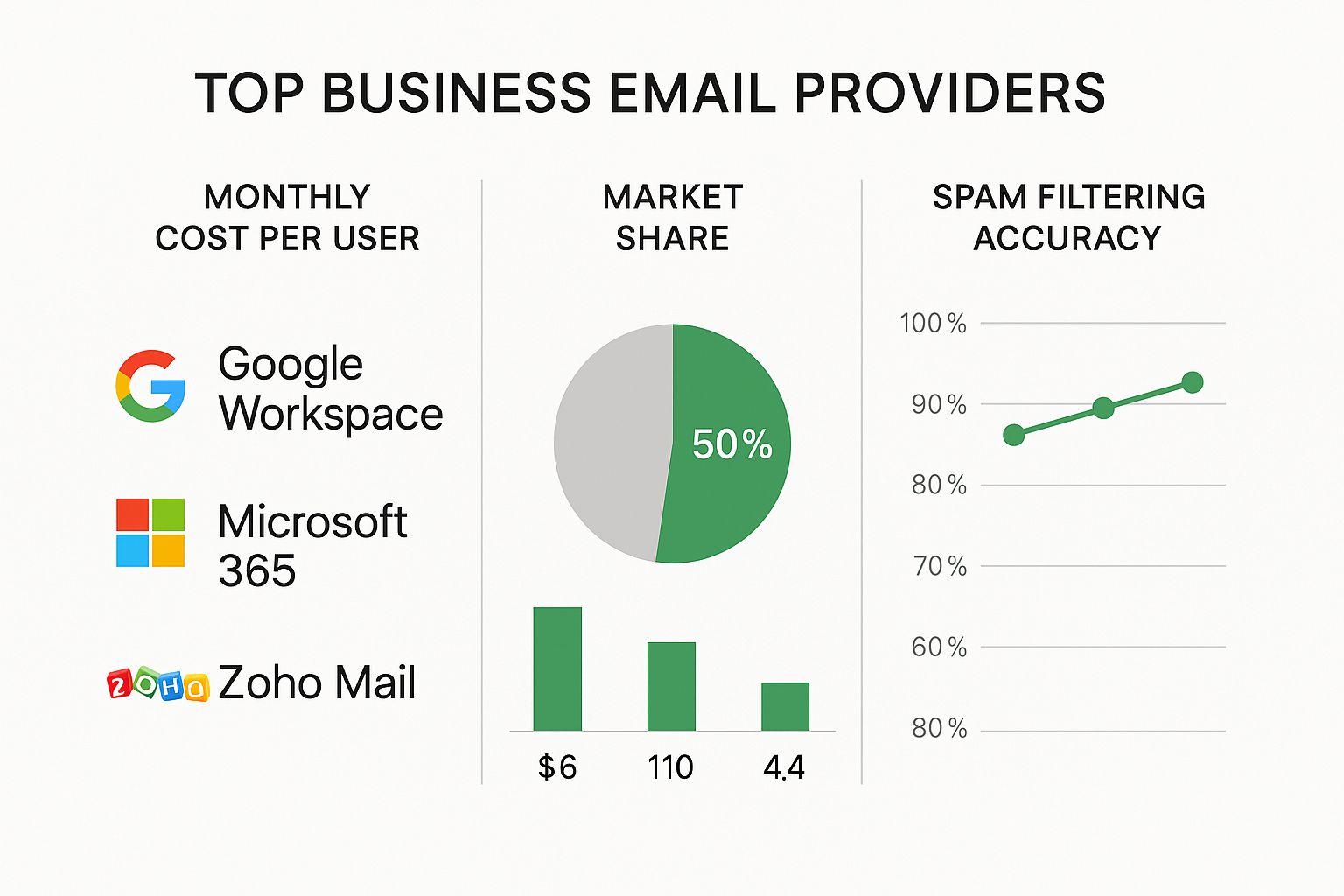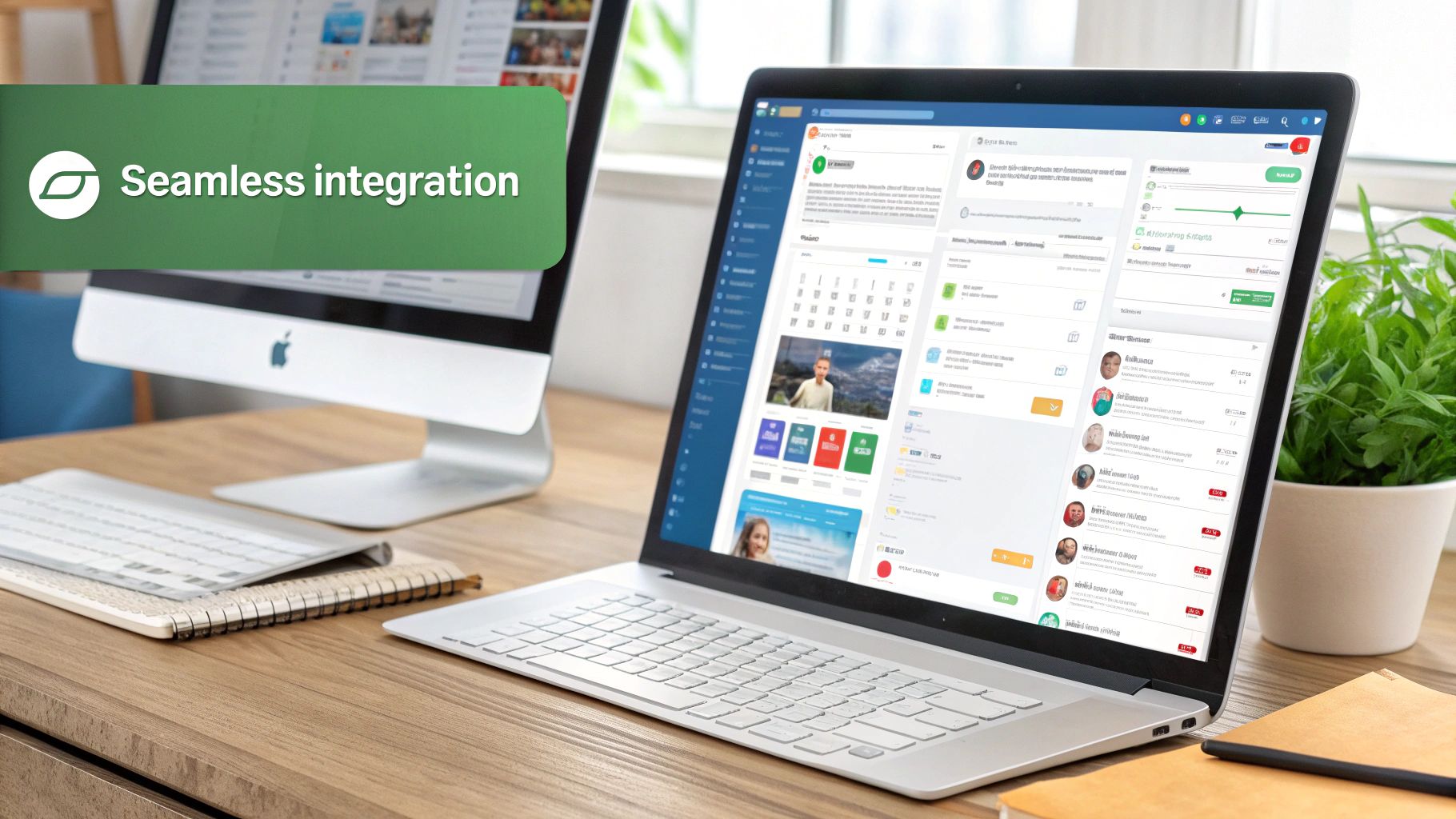Finding the Best Business Email Providers

For most companies, the conversation around the best business email provider almost always narrows down to three major players: Google Workspace, Microsoft 365, and Zoho Mail. These services have become industry standards for a reason—they offer a solid mix of reliability, top-tier security, and a whole suite of productivity tools that extend far beyond a simple inbox.
But the "best" choice really depends on how your team already works, what your budget looks like, and the specific security demands of your industry.
How To Choose Your Business Email Provider
Your business email is more than just a way to send and receive messages; it's a core part of your brand. An email address like contact@yourcompany.com instantly conveys professionalism and helps build trust with clients and partners in a way a generic address never could. Picking the right provider is what ensures those critical communications are secure, dependable, and always online.
Choosing an email provider is a lot like doing a business intelligence tools comparison. You have to look past the shiny features on the surface and really dig into which service will fit seamlessly into your day-to-day operations.
Core Factors To Evaluate
When you're weighing your options, there are four key areas that should be at the top of your checklist. These pillars directly affect your performance, security, and sanity.
- Security and Privacy: Non-negotiables here include powerful spam filtering, phishing detection, and two-factor authentication (2FA). For any business handling sensitive data, end-to-end encryption is an absolute must-have.
- Reliability and Uptime: Your email simply has to work. All the time. The best providers guarantee 99.9% uptime through formal Service Level Agreements (SLAs), giving you peace of mind that you'll never miss a crucial email because of downtime.
- Scalability and Management: The right provider makes growth easy. As your team expands, you should be able to add or remove user accounts, increase storage, and manage permissions from one central dashboard without any headaches.
- Integration and Features: A modern business email account is the command center for your workday. Think about how well it connects with the tools you already rely on, like calendars, cloud storage, and video conferencing apps. If you want to get into the weeds on this, our guide can help you compare email providers for your needs.
The infographic below gives a great visual breakdown of how the top contenders measure up on important metrics like cost, market share, and their effectiveness at filtering out spam.

As the chart shows, there's a clear trade-off between market dominance and price. While some providers have a massive user base, others are competing with much more aggressive pricing.
The Role Of Email In Modern Business
Email isn't going anywhere. It remains the backbone of professional communication. With over 4.5 billion users worldwide—a number expected to climb past 4.8 billion by 2027—its role is more cemented than ever. This is especially true for businesses, where a staggering 64% of small enterprises use email marketing as their primary way to reach customers. It’s a foundational tool for driving real engagement and revenue.
To kick things off, here's a quick look at the top options to give you a lay of the land before we dive into the details.
Top Business Email Providers at a Glance
This table offers a high-level comparison of the leading business email providers, highlighting their core strengths, typical pricing, and the type of business they are best suited for.
| Provider | Best For | Starting Price (Per User/Month) | Key Feature Highlight |
|---|---|---|---|
| Google Workspace | Teams valuing collaboration and a modern UI | $6.00 | Seamless integration with Docs, Sheets, and Meet |
| Microsoft 365 | Businesses standardized on Windows and Office | $6.00 | Deep integration with the full Microsoft Office suite |
| Typewire | Privacy-focused businesses and individuals | $3.00 | No tracking, no ads, and total data privacy |
| Zoho Mail | Small businesses seeking an affordable, all-in-one suite | $1.00 | Includes a robust CRM and other business apps |
This gives you a starting point for understanding where each provider excels. Now, let's explore what sets them apart.
Comparing Core Features and Usability
The best business email service is more than just an inbox; it’s the command center for your team's productivity. A clean, easy-to-use interface is non-negotiable. If your team can't get up and running without hours of training, you've already lost the battle.
Platforms like Google Workspace really shine here, especially with their modern, web-first design. Most people have used Gmail at some point, so the interface feels instantly familiar. That means your team can immediately start using its powerful search and smart labels to stay organized, cutting down on adoption friction.

On the other hand, Microsoft 365 and its Outlook client offer a more traditional, feature-packed experience. It’s undeniably powerful, but it can feel a bit overwhelming if you're not already living in the Microsoft world. For businesses that are already heavily invested in Office apps, however, that tight-knit design is a massive plus.
Evaluating Integration Ecosystems
Here’s where the real value kicks in. An email platform’s ability to talk to your other business tools—your CRM, project management software, calendars—is what separates a good service from a great one. Seamless integration can save you from a thousand tiny administrative headaches.
Google Workspace is a master of this, with native hooks into Docs, Sheets, and Meet, plus a huge marketplace of third-party add-ons. Think about your sales team being able to log client conversations in their CRM without ever leaving the Gmail window. That's a real time-saver.
Microsoft 365's superpower is its deep connection with the Office suite and Microsoft Teams. A project manager can instantly convert an email into a task in Planner or kick off a Teams meeting right from an Outlook thread. Little workflow boosts like this add up. When you're thinking about usability, even simple features matter. For instance, knowing how to use voice typing on Gmail can make a huge difference for anyone trying to clear their inbox on the go.
A truly effective email provider doesn't just manage messages—it centralizes your team's entire workflow. The quality of its integration ecosystem is a direct measure of its potential to reduce friction and boost overall productivity.
A Practical Comparison of Core Tools
Let's walk through a common scenario to see how this plays out. Imagine your team is kicking off a new marketing proposal.
-
With Google Workspace: You'd get an email, spin up a new Google Doc from a template, and share it with the team directly from Gmail. All the feedback and edits happen in real-time within the document, and you get notifications right in your inbox. It's a very smooth, continuous loop.
-
With Microsoft 365: The flow is similar but built around Microsoft's toolset. An email in Outlook would lead to creating a Word document, which gets saved to SharePoint. Collaboration would then shift over to a dedicated Teams channel, keeping all the files and chats neatly organized by project.
Both methods get the job done, and done well. The "better" choice really comes down to how your team already operates. If you pick a provider whose workflow mirrors your existing habits, you'll see a much smoother rollout and get everyone on board faster.
A Closer Look at Security and Privacy
In a world where data breaches make headlines daily, the security of your business email isn't just a feature—it's your first line of defense. We need to think beyond basic spam filters. The best business email providers now use a layered approach to protect your communications from increasingly clever threats.
At a minimum, this means multi-factor authentication (MFA) should be standard, not an optional extra. MFA is that crucial second step, ensuring that even if a password gets compromised, your account stays locked down without a verification code from your phone.
Encryption: The Cornerstone of Secure Communication
When we talk about security, we're really talking about encryption. But here's the catch: not all encryption is the same. Most big-name providers, like Gmail, rely on Transport Layer Security (TLS). Think of it like a secure tunnel; your email is protected while it travels between servers, but the provider can still see the contents once it arrives.
For any business that handles sensitive information—client data, legal contracts, or trade secrets—that's a huge risk. This is where end-to-end encryption (E2EE) completely changes the game. With E2EE, your message is locked before it even leaves your device, and only the person you send it to has the key to unlock it. No one else, not even your email provider, can get a peek.
The real question in email security is simple: who holds the keys? If your provider can scan your emails to offer smart replies or targeted ads, your data is never truly private. Zero-access encryption puts the keys back in your hands.
This zero-access architecture is the bedrock of privacy-focused services like Typewire. If you want to dig deeper into the nuances, our guide to the top 10 best encrypted email services for privacy in 2025 is a great resource.
Advanced Threat Protection and Data Policies
Beyond encryption, today’s top-tier email security uses AI to spot and stop threats before they happen. These systems are constantly scanning incoming messages for phishing schemes, malware, and impersonation attempts, neutralizing them long before they land in an employee's inbox.
Another critical piece of the puzzle is the provider's privacy policy and where they physically store your data. It matters more than you think.
- Data Sovereignty: A provider headquartered in a country with robust privacy laws, like Switzerland or Germany, offers much stronger legal safeguards against government snooping than one based in the U.S.
- Data Loss Prevention (DLP): For larger companies, DLP tools are a lifesaver. They let you create rules to block sensitive information—think credit card numbers or confidential project files—from being accidentally or intentionally sent outside the organization.
When you're comparing the best business email providers, you have to look past the marketing jargon. Demand transparency about their encryption methods, read their data policies carefully, and choose a partner whose commitment to privacy is real. Your business's reputation and your customers' trust are riding on it.
Getting Your Emails Delivered and Staying Online
An email service is only as good as its ability to actually deliver your messages. It sounds obvious, but beyond all the bells and whistles, two technical factors are make-or-break for any business: deliverability and uptime. If your emails don't reliably hit the inbox, or if your service goes down, nothing else matters.
Think about it. Your sales quotes, client contracts, and marketing messages need to land in the primary inbox, not get lost in a spam filter. This is where the infrastructure and reputation of the best business email providers really come into play.

Why Deliverability is Everything
Poor deliverability is a silent killer for business. Every email flagged as spam is a lost opportunity, a missed deadline, or a tiny crack in your brand's reputation. It’s precisely why giants like Google Workspace and Microsoft 365 pour so many resources into maintaining pristine sending servers.
The numbers don't lie. Data from Q2 2025 showed that inbox placement rates can fluctuate quite a bit, but the top providers are always working to improve. Google Workspace saw its rate climb from 53.36% to 58.6%—a solid 5.24% jump. Microsoft wasn't far behind, with Outlook and Hotmail placement rates increasing by 4.98% and 5.67%. These stats, which you can explore in more detail with these email deliverability statistics, show that a provider’s ongoing investment directly impacts whether your audience ever sees your message.
The real job of a business email provider isn’t just sending an email—it’s making sure that email gets seen. High deliverability is the difference between starting a conversation and being ignored by a spam filter.
Uptime Guarantees and Why They Matter
Just as critical as getting your emails delivered is having a service that's always on. Uptime is the percentage of time your email service is actually running and available. Even a couple of hours of downtime can throw your entire operation into chaos, bringing customer support and sales to a screeching halt.
This is why the best providers offer a Service Level Agreement (SLA), which is a formal promise to keep the lights on.
- Google Workspace SLA: Promises a 99.9% uptime for its core services, including Gmail.
- Microsoft 365 SLA: Also provides a financially-backed 99.9% uptime guarantee on its business plans.
That 99.9% figure means you can expect no more than a few minutes of unscheduled downtime per month. While these SLAs offer peace of mind, it’s always smart to look up a provider’s historical performance on their status pages. A proven track record of reliability is your best defense against costly communication breakdowns. For more hands-on advice, check out our guide to improving email deliverability.
Breaking Down Pricing Models and Scalability
Figuring out the true cost of a business email service is crucial for staying on budget and planning for the future. It’s easy to get drawn in by low introductory prices, but the real value is in what each plan actually includes and how well it can grow with you. Let's be honest, a cheap plan that forces you into an expensive upgrade six months down the road isn't a bargain.
The most common way providers charge is the per-user, per-month model. It's popular for a reason—it’s predictable and scales easily. You only pay for what you use, making it simple to add a new hire or remove an account when someone leaves. Giants like Google Workspace and Microsoft 365 have built their empires on this kind of flexibility.
But that headline price? It's just the starting point. The best email providers separate their plans based on a few key factors that will absolutely affect your day-to-day operations.
Comparing Costs Beyond the Monthly Fee
When you’re looking at pricing, you have to look past the sticker price. The features bundled into each plan are what determine its actual value. A slightly more expensive tier might actually save you money if it includes tools you’d otherwise have to buy separately.
Think about these critical differences:
- Storage Limits: A basic plan might give you 30 GB of storage, but a higher-tier one could offer a whopping 2 TB. If you’re a creative agency constantly sending massive files, that extra space isn't a luxury—it's essential.
- Integrated Apps: Does the plan come with a full productivity suite? Microsoft 365 bundles Word, Excel, and PowerPoint. Meanwhile, Zoho Mail often includes its powerful CRM, which can be a huge value-add.
- Security Features: Advanced security tools like eDiscovery, data loss prevention (DLP), and email archiving are almost always reserved for premium or enterprise-level plans. For businesses in regulated fields, these aren't just nice-to-haves; they're non-negotiable.
The cheapest plan is rarely the most cost-effective. A thorough cost-benefit analysis means matching a plan's features—like storage, security, and included apps—to your actual daily workflow, not just your initial budget.
Planning for Future Growth
Scalability is where a provider’s flexibility is really put to the test. Your email service should never hold your business back. A solo entrepreneur might get by just fine with Zoho's free plan, but as soon as they start hiring, they’ll need a system that lets them upgrade smoothly without causing a massive headache.
This is an area where the industry leaders really shine. Both Google Workspace and Microsoft 365 have clear upgrade paths, allowing you to move from a basic plan to an enterprise-level one with just a few clicks. This ensures that as your team grows and your security needs get more complex, your email platform can grow right along with you.
To see how these details really stack up, it helps to put them side-by-side.
Feature and Cost Comparison by Tier
Here’s a quick breakdown of what you get for your money with some of the top providers. This isn't just about the price tag; it's about what that price actually buys you in terms of storage, security, and extra tools.
| Provider | Plan Tier | Price (Per User/Month) | Storage per User | Key Security Feature | Included Apps/Suite |
|---|---|---|---|---|---|
| Google Workspace | Business Starter | $6.00 | 30 GB | Phishing & spam protection | Docs, Sheets, Meet, Drive |
| Microsoft 365 | Business Basic | $6.00 | 1 TB | Advanced Threat Protection | Teams, Word, Excel (Web) |
| Zoho Mail | Mail Premium | $4.00 | 50 GB | S/MIME encryption | Zoho Calendar & Contacts |
| Typewire | Premium | $5.00 | 10 GB | Zero-access encryption | Private Calendar |
This comparison really highlights the trade-offs you have to make. While Typewire is laser-focused on providing best-in-class privacy with its zero-access encryption, Microsoft goes all-in on storage. Ultimately, picking the right provider means figuring out which of these details aligns best with your business’s long-term goals.
How to Make the Right Choice for Your Business
Picking the right business email provider isn't about finding some mythical "best" option. It’s about finding the one that fits your business like a glove—your size, your industry, and what you value most. After you've weighed all the features, security protocols, and price tags, the real work begins: matching a provider's strengths to your actual day-to-day operations.
This is how you cut through the marketing noise. Are you a one-person shop who just needs a professional you@yourdomain.com address without spending a fortune? Or are you a scaling startup where integrated tools for collaboration are absolutely critical? Each of these scenarios points to a very different solution.

Think about it this way: an established company in a regulated field like finance or healthcare has to put security and compliance above everything. For them, the search starts and ends with features like data loss prevention (DLP) and guaranteed end-to-end encryption to keep sensitive client data locked down.
Matching Provider Strengths to Business Needs
To make things even clearer, let's connect the dots between what these providers do well and who they're built for. This helps turn a list of technical specs into real business advantages.
-
For the Solopreneur or Freelancer: You need to look professional on a tight budget. A service like Zoho Mail is a fantastic starting point. It gives you a custom domain email and the basic tools you need to build credibility without draining your bank account.
-
For the Growing Startup: Your team lives and breathes collaboration. This is where Google Workspace shines. The seamless connection between Gmail, Docs, and Meet creates an efficient workflow that helps fast-moving teams stay in sync.
-
For the Privacy-Focused Organization: If your communications are your most valuable asset, you can't settle. Typewire was designed from the ground up with a zero-access encryption model. It guarantees that no one—not even us—can read your messages besides you and your intended recipient.
Email is still the engine that drives business. In 2025, surveys showed that 59% of B2B marketers called email their most effective revenue channel. With 81% of businesses relying on email newsletters, the provider you choose has a direct line to your bottom line. You can find more stats on email marketing's power on Wix.com.
The best email provider should feel like a natural extension of how you already work. The final decision shouldn't just be about features, but about how a provider's core philosophy aligns with your own—whether you prioritize open collaboration, ironclad security, or absolute privacy.
When you look at providers through the lens of your own unique needs, you can confidently choose a partner that doesn't just work for you today but is ready to grow with you tomorrow.
Got Questions About Business Email? We've Got Answers.
Choosing the right business email provider can feel like a big commitment, and it's natural to have a few last-minute questions. Let's clear up some of the most common ones so you can make a choice you feel great about.
Is It a Headache to Switch Email Providers?
Not at all. Migrating your email from one service to another has become a pretty standard, streamlined process. Most of the top providers have built-in tools designed specifically to make the move as painless as possible.
These migration services can pull over all your old emails, contacts, and even your carefully organized folder structures. When you move to a platform like Google Workspace or Microsoft 365, they guide you through the whole thing. It’s always smart to back up your critical data first, but the switch itself is usually smoother than people think.
Why Can't I Just Use My Free Gmail Address?
You could, but it would be a mistake. A custom domain email (think jane@yourcompany.com) is one of the easiest ways to establish instant credibility. It shows potential clients and partners you're running a serious, legitimate operation.
Frankly, an email address is often your first impression. An address from a free service looks amateur and can undermine a client's confidence before you've even had a conversation.
Besides looking professional, using your own domain reinforces your brand with every single message you send. It’s a small detail that makes a huge difference in how your business is perceived.
How Long Does It Really Take to Get Set Up?
This is the best part—it's surprisingly fast. For most small businesses using a provider like Typewire or Zoho Mail, you can have your new email up and running in less than an hour. The main steps are just verifying you own your domain and updating a couple of simple settings where you bought it.
If you're migrating a large team with years of archived data, the whole process might take a bit longer, maybe a few hours. But getting the basics in place to send and receive your first professional email? That happens fast.
Ready to stop worrying about your email privacy? Typewire is built on end-to-end encryption and a zero-tracking philosophy, ensuring your business conversations stay yours. Start your free 7-day trial and experience true email privacy today.
Finding the Best Business Email Providers
Posted: 2025-08-20
A Practical Guide on How to Send Email Encrypted for Total Privacy
Posted: 2025-12-06
How to Host a Mail Server for Ultimate Email Privacy and Security
Posted: 2025-12-05
What Is Spear Phishing and How Do You Stop It
Posted: 2025-12-04
Building Your Digital Workspace Solutions
Posted: 2025-12-03
Business Email vs Personal Email A Guide to Security
Posted: 2025-12-02
How to Create Professional Email Address: Setup, Security, and Privacy
Posted: 2025-12-01
Email Retention Policy Template for Security and Compliance
Posted: 2025-11-30
Data Residency Requirements for Secure Hosted Email
Posted: 2025-11-29